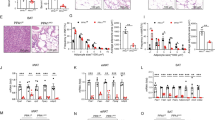Abstract
The phosphotyrosine interaction domain containing 1 (PID1) gene was firstly isolated from obese subjects and involved in obesity-associated insulin resistance. In the present study, Duroc×Landrace×Yorkshire (DLY) pig PID1 cDNA was cloned. The entire open reading frame of the cloned porcine PID1 is 654 bp. The predicted protein is composed of 217 amino acids residues with a molecular mass of 24,774 Da. Over-expression of porcine PID1 significantly accelerated the proliferation of 3T3-L1 preadipocyte, but inhibited preadipocyte differentiation by decreasing the numerous fat droplets appeared and down-regulating the mRNA expression levels of peroxisome proliferators-activated receptor-γ, CCAAT/enhancer binding protein α, fat acid synthase and lipoprotein lipase. Together, these results suggest that porcine PID1 plays a role in regulating adipose development.
Similar content being viewed by others
Abbreviations
- ADD1:
-
adipocyte determination and differentiation factor-1
- C/EBP-α :
-
CCAAT/enhancer binding protein α
- DLY:
-
Duroc×Landrace×Yorkshire
- DMEM:
-
Dulbecco’s modified Eagle’s medium
- EdU:
-
5-ethynyl-2’-deoxyuridine
- FAS:
-
fat acid synthase
- FBS:
-
fetal bovine serum
- LPL:
-
lipoprotein lipase
- PID1:
-
phosphotyrosine interaction domain containing 1
- PPAR-γ :
-
peroxisome proliferators-activated receptor-γ
References
Benson D.A., Cavanaugh M., Clark K., Karsch-Mizrachi I., Lipman D.J., Ostell J. & Sayers E.W. 2013. GenBank. Nucleic Acids Res. 41(Database issue): D36–D42.
Chen X., Huang Z., Chen D., Jia G., Mao X. & Wu X. 2012. Role of NYGGF4 in insulin resistance. Mol. Biol. Rep. 39: 5367–5371.
Fortin A., Robertson W.M. & Tong A.K.W. 2005. The eating quality of Canadian pork and its relationship with intramuscular fat. Meat Sci. 69: 297–305.
Green H. & Meuth M. 1974. An established pre-adipose cell line and its differentiation in culture. Cell 3: 127–133.
Goldberg I.J. 1996. Lipoprotein lipase and lipolysis: central roles in lipoprotein metabolism and atherogenesis. J. Lipid Res. 37: 693–707.
Goodpaster B.H. & Wolf D. 2004. Skeletal muscle lipid accumulation in obesity, insulin resistance, and type 2 diabetes. Pediatr. Diabetes 5: 219–226.
Gregoire F.M., Smas C.M. & Sul H.S. 1998. Understanding adipocyte differentiation. Physiol. Rev. 78: 783–809.
Kusakabe T., Maeda M., Hoshi N., Sugino T., Watanabe K., Fukuda T. & Suzuki T. 2000. Fatty acid synthase is expressed mainly in adult hormone-sensitive cells or cells with high lipid metabolism and in proliferating fetal cells. J. Histochem. Cytochem. 48: 613–622.
Lin Q., Lee Y.J. & Yun Z. 2006. Differentiation arrest by hypoxia. J. Biol. Chem. 281: 30678–30683.
Liu W. & Saint D. 2002. Validation of a quantitative method for real time PCR kinetics. Biochem. Biophys. Res. Commun. 294: 347–353.
Livak K.J. & Schmittgen T.D. 2001. Analysis of relative gene expression data using real-time quantitative PCR and the 2−ΔΔ C T method. Methods 25: 402–408.
Man C., Li X. & Zhao D. 2011. Cloning, sequence identification, and tissue expression analysis of novel chicken NYGGF4 gene. Mol. Cell. Biochem. 346: 117–124.
Poulos S.P., Dodson M.V. & Hausman G.J. 2010. Cell line models for differentiation: preadipocytes and adipocytes. Exp. Biol. Med. 235: 1185–1193.
Qian Y., Zeng Q.Y., Cui J.X., Chen Q.M., Song Y.P., Du J.F. & Chen W. 2011. Functional analysis and tissue specific expression profile of PID1 gene in Laiwu pig. Acta Veterinaria et Zootechnica Sinica 42: 621–628.
Qian Y., Zeng Y.Q., Du J.F., Cui J.X., Li H., Chen Q.M., Song Y.P. & Chen W. 2010. CDS cloning and relationship between intramuscular fat content and mRNA expression of PID1 gene in pig. Hereditas 32: 1153–1158.
Rosen E.D. & Spiegelman B.M. 2000. Molecular regulation of adipogenesis. Annu. Rev. Cell Dev. Biol. 16: 145–171.
Semenkovich C.F. 1997. Regulation of fatty acid synthase (FAS). Progr. Lipid Res. 36: 43–53.
Wang B., Zhang M., Ni Y.H., Liu F., Fan H.Q., Fei L., Pan X.Q., Guo M., Chen R.H. & Guo X.R. 2006. Identification and characterization of NYGGF4, a novel gene containing a phosphotyrosine-binding (PTB) domain that stimulates 3T3-L1 preadipocyte proliferation. Gene 379: 132–140.
Wu W.L., Gan W.H., Tong M.L., Li X.L., Dai J.Z., Zhang C.M. & Guo X.R. 2011. Over-expression of NYGGF4 (PID1) inhibits glucose transport in skeletal myotubes by blocking the IRS1/PI3K/AKT insulin pathway. Mol. Genet. Metab. 102: 374–377.
Zhang C.M., Chen X.H., Wang B., Liu F., Chi X., Tong M.L., Ni Y.H., Chen R.H. & Guo X.R. 2009. Over-expression of NYGGF4 inhibits glucose transport in 3T3-L1 adipocytes via attenuated phosphorylation of IRS-1 and Akt. Acta Pharmacol. Sin. 30: 120–124.
Zhao Y., Zhang C., Chen X., Gao C., Ji C., Chen F., Zhu C., Zhu J., Wang J., Qian L. & Guo X. 2010a. Overexpression of NYGGF4 (PID1) induces mitochondrial impairment in 3T3-L1 adipocytes. Mol. Cell. Biochem. 340: 41–48.
Zhao Y., Zhang C., Zhu C., Chen X., Wang J., Ji C., Chi X., Hong Q., Peng Y. & Guo X. 2010b. NYGGF4 homologous gene expression in 3T3-L1 adipocytes:regulation by FFA and adipokines. Mol. Biol. Rep. 37: 3291–3296.
Author information
Authors and Affiliations
Corresponding author
Rights and permissions
About this article
Cite this article
Chen, X., Huang, Z., Wang, H. et al. Porcine phosphotyrosine interaction domain containing 1 modulates 3T3-L1 preadipocyte proliferation and differentiation. Biologia 68, 1010–1014 (2013). https://doi.org/10.2478/s11756-013-0240-0
Received:
Accepted:
Published:
Issue Date:
DOI: https://doi.org/10.2478/s11756-013-0240-0




